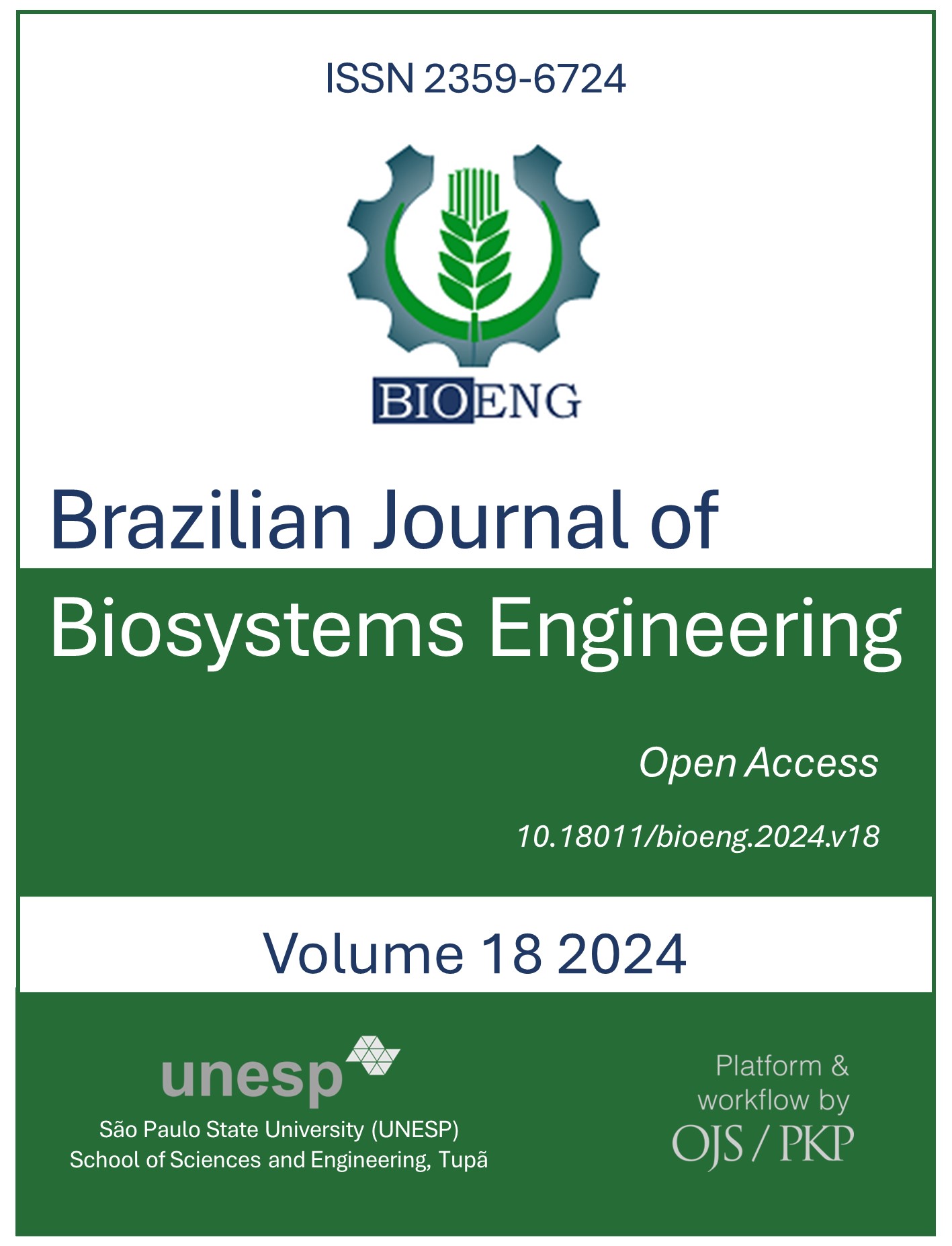The participation of family farming production in the Brazilian basic food basket items
DOI:
https://doi.org/10.18011/bioeng.2024.v18.1236Keywords:
Family Farming, Basic Food Basket, Food Production, Food SecurityAbstract
Family farming is an important social organization, it is the focus of many studies and public policies. It provides food for society and plays a role in regional development, and food and nutritional security. Family farms represent 90% of the agricultural establishments worldwide and 77% in Brazil. From this, it is important to understand the degree of importance of family farmers in food production. Therefore, the objective of this research is to analyze the participation of family farming in the production of Brazilian basic food basket items. Not all items were directly used because some of them were industrialized, such as sugar, and then some substitutes were chosen, like sugarcane. This is possibly the main limitation of this research. The results indicate there is varied participation of family farming production among the items, ranging from 1.93% (sugarcane) to 84.55% (coffee beans). The literature indicates different percentages of participation of family farming in agricultural production, depending on the definition of family farming and the crops considered for analysis. In this research, the results indicate a general participation of 17.21% for the Brazilian basic food basket items. As exploratory research, the results are considered satisfactory and can contribute to the formulation of public and private policies concerning food production and supply.
Downloads
References
Abramovay, R. (2000). O capital social dos territórios: repensando o desenvolvimento rural. Economia Aplicada, 4(2), 379–397. https://doi.org/https://doi.org/10.11606/1413-8050/ea218794
Assis, R. L. (2006). Desenvolvimento rural sustentável no Brasil: perspectivas a partir da integração de ações públicas e privadas com Base na agroecologia. Economia Aplicada, 10(1), 75–89. DOI: https://doi.org/10.1590/S1413-80502006000100005
Brazil. (1938). Decreto-Lei no 399 de 30/04/1938. Coleção de Leis Do Brasil de 31/12/1938 - Vol. 002. https://legis.senado.leg.br/norma/523433/publicacao/15708212
Brazil. (2017). Decreto No 9.064, de 31 de maio de 2017. Diário Oficial da União, Seção 1. https://legislacao.presidencia.gov.br/atos/?tipo=DEC&numero=9064&ano=2017&ato=d88oXRE1UeZpWTd3c
CONAB. (2024). Oferta e Demanda de Grãos. https://www.conab.gov.br/info-agro/analises-do-mercado-agropecuario-e-extrativista/analises-do-mercado/oferta-e-demanda-de-graos
Costabeber, J. A., & Caporal, F. R. (2003). Possibilidades e alternativas do desenvolvimento rural sustentável. Agricultura Familiar e Desenvolvimento Rural Sustentável No Mercosul, 157–194.
Deponti, C. M., & Preiss, V. (2021). Covid-19, a agricultura familiar e desenvolvimento regional: uma análise da Região do Vale do Caí, RS. X Seminário Internacional Sobre Desenvolvimento Regional, 1–20. https://online.unisc.br/acadnet/anais/index.php/sidr/article/view/21239
DIEESE. (2016). Metodologia da Pesquisa Nacional da Cesta Básica de Alimentos. https://www.dieese.org.br/metodologia/metodologiaCestaBasica2016.pdf
FAO. (2012). The role of FAO’s Plant Production and Protection Division. https://www.fao.org/ag/agp/greenercities/pdf/CDSDN.pdf
FAO. (2014). International Year of Family Farming 2014. https://www.fao.org/fileadmin/user_upload/iyff/docs/Final_Master_Plan_IYFF_2014_30-05.pdf
FAO. (2019). Putting family farmers at the centre to achieve the SDGs. FAO.
Gazolla, M., Tomporoski, A. A., Conterato, M. A., Sabourin, E. P., Rambo, A. G., Bernartt, M. de L., & Pedrassani, D. (2022). Agricultura familiar: Contribuições para o desenvolvimento regional no Sul do Brasil. DRd - Desenvolvimento Regional Em Debate, 12(ed.esp.Dossie), 1–6. https://doi.org/10.24302/drd.v12ied.esp.Dossie.4174 DOI: https://doi.org/10.24302/drd.v12ied.esp.Dossie.4174
Georgeou, N., Hawksley, C., Wali, N., Lountain, S., Rowe, E., West, C., & Barratt, L. (2022). Food security and small holder farming in Pacific Island countries and territories: A scoping review. PLOS Sustainability and Transformation, 1(4), e0000009. https://doi.org/10.1371/journal.pstr.0000009 DOI: https://doi.org/10.1371/journal.pstr.0000009
Hoffmann, R. (2014). A agricultura familiar produz 70% dos alimentos consumidos no Brasil? Segurança Alimentar e Nutricional, 13(1), 417. https://doi.org/10.20396/san.v21i1.1386 DOI: https://doi.org/10.20396/san.v21i1.1386
IBGE. (2012). Censo Agropecuário 2006. IBGE. https://ftp.ibge.gov.br/Censo_Agropecuario/Censo_Agropecuario_2006/Segunda_Apuracao/censoagro2006_2aapuracao.pdf
IBGE. (2019). Censo Agropecuário 2017. IBGE. https://biblioteca.ibge.gov.br/index.php/biblioteca-catalogo?view=detalhes&id=73096
Kageyama, A. A., Bergamasco, S. M. P. P., & Oliveira, J. T. A. de. (2013). Uma tipologia dos estabelecimentos agropecuários do Brasil a partir do censo de 2006. Revista de Economia e Sociologia Rural, 51(1), 105–122. https://doi.org/10.1590/S0103-20032013000100006 DOI: https://doi.org/10.1590/S0103-20032013000100006
Marques, F. C., Conterato, M. A., & Schneider, S. (2016). Construção de mercados e agricultura familiar: desafios para o desenvolvimento rural. Editora da UFRGS.
Medina, G., Almeida, C., Novaes, E., Godar, J., & Pokorny, B. (2015). Development Conditions for Family Farming: Lessons From Brazil. World Development, 74, 386–396. https://doi.org/10.1016/j.worlddev.2015.05.023 DOI: https://doi.org/10.1016/j.worlddev.2015.05.023
Scarabelot, M., & Schneider, S. (2012). As cadeias agroalimentares curtas e o desenvolvimento local: um estudo no município de Nova Veneza-SC. Revista Faz Ciência, 14(19), 101–130. https://doi.org/https://doi.org/10.48075/rfc.v14i19.8028
Schneider, S. (2016). A presença e as potencialidades da Agricultura Familiar na América Latina e no Caribe. Redes, 21(3), 11–33. https://doi.org/10.17058/redes.v21i3.8390 DOI: https://doi.org/10.17058/redes.v21i3.8390
Sène-Harper, A. L., Camara, S. M. E., & Matarrita-Cascante, D. (2019). Does Diversification Lead to Livelihood Security in Fishing-Farming Communities? Insight from the Senegal River Delta. Human Ecology, 47(6), 797–809. https://doi.org/10.1007/s10745-019-00121-8 DOI: https://doi.org/10.1007/s10745-019-00121-8
Downloads
Published
How to Cite
Issue
Section
License
Copyright (c) 2024 Revista Brasileira de Engenharia de Biossistemas

This work is licensed under a Creative Commons Attribution 4.0 International License.
Authors who publish in this journal agree to the following terms:
a) Authors retain the copyright and grant the journal the right of first publication, with the work simultaneously licensed under the Creative Commons Attribution License that allows the sharing of the work with recognition of authorship and initial publication in this journal.
b) Authors are authorized to assume additional contracts separately, for non-exclusive distribution of the version of the work published in this journal (eg, publish in an institutional repository or as a book chapter), with recognition of authorship and initial publication in this journal.








